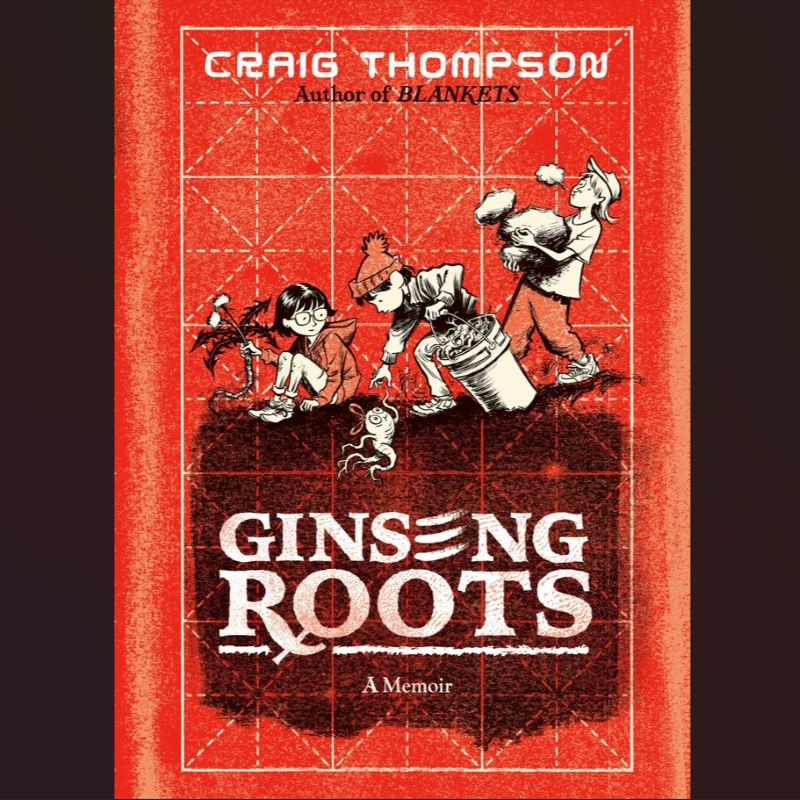By Laura McCarthy.
Ginseng Roots is part memoir and part history of Asia, in which graphic novelist Craig Thompson tells the narrative of his life, exploring his working class roots, stemming from a childhood spent farming ginseng in Wisconsin. The thread of ginseng runs throughout the novel, as we see Thompson and his siblings growing the herb as children, earning just enough to buy the comic books which inspired his love of illustration and storytelling; we see Thompson’s travels through China, Korea, and Japan, with ginseng always at the heart of the journey; we see the medicinal impact of the plant on his worsening Fibromatosis.
The roots of the ginseng plant are a fitting metaphor for the narrative, as Thompson examines his own roots, his own background, and the growing plants reflect the growth of Craig and those around him. The story he tells is one full of humanity in which there are moments of humour, inner turmoil, the sentimental, the nostalgic, and the painful. He tells the narrative through well considered language which is sometimes grounded and real, sometimes layered with lyrical passages with poetic, symbolic imagery.
The art is some of Thompson’s best: an almost ironic tragedy considering that Thompson discusses how the onset of the autoimmune disorder Fibromatosis causes his hands to deteriorate. This personal crisis, among others, is expressed powerfully through artistic choices throughout. Craig Thompson’s characteristic art style which melds the cartoonish with a realistic base, drawn with those familiar dark lines of Habibi and Blankets, is elevated with the use of red. Red is the only colour used within the illustrations, representing the red fruit of ginseng plants. This fruit only develops after a long, difficult season of labour, mirroring the challenges of life. In the graphic novel, this colour translates into moments of victory, or danger, or the everyday made beautiful. The absence of red is also used to emphasise moments of depression.
Stylistic decisions heighten the narrative, with the most beautiful aspects, like drawings of growing plants, created with twirling lines, appearing most fairy-like. Thompson personifies plants, using varying art styles to give them character. On the one hand, we see snapping, biting, or ghoulish weeds. On the other, we see the adorable, lovable, sometimes vulnerable ginseng with big cartoon eyes. The ginseng cartoon in particular is a motif we see multiple times, transforming into a Jiminy Cricket style conscience or voice of inner doubt at times. He also merges aspects of Asian art with his own, suiting the themes of the narrative (for example, we see him pay homage to Hokusai’s The Great Wave Off Kanagawa). His sibling Phil also illustrates portions of the novel in order to present his own perspective on events which are happening to both brothers. This is a strong choice to highlight the contrast of their opinions in moments of tension between them. At other times, Phil’s drawings weave into Craig’s to show their unity.
Thompson steers away from the typical use of comic strip style boxes to tell his tale. Instead, each page is creatively composed, almost like collages. Compared to other graphic novels, or even his own older work, this may be some of the most exciting composition out there. Every page is different. Every page is a masterpiece.
Ginseng Roots by Craig Thompson, published by Pantheon Books, will be available from April 29th.
- In Common is not for profit. We rely on donations from readers to keep the site running. Could you help to support us for as little as 25p a week? Please help us to carry on offering independent grass roots media. Visit: https://www.patreon.com/incommonsoton

